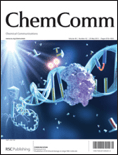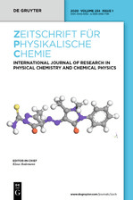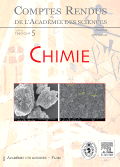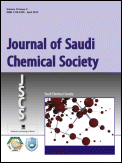
CHEMICAL PAPERS
Scope & Guideline
Advancing Innovation in Chemical Sciences
Introduction
Aims and Scopes
- Synthesis and Characterization of Nanomaterials:
The journal frequently publishes studies on the synthesis, characterization, and application of nanomaterials, emphasizing their properties and potential uses in fields such as catalysis, drug delivery, and environmental remediation. - Green Chemistry and Sustainable Practices:
A significant focus is placed on green chemistry methodologies and sustainable practices, including the development of eco-friendly synthesis routes, waste valorization, and the use of renewable resources. - Analytical Chemistry Techniques:
Research articles often explore innovative analytical techniques for detecting, quantifying, and characterizing chemical substances, especially in environmental and biological matrices. - Photocatalysis and Environmental Remediation:
The journal highlights studies on photocatalytic processes and their applications in environmental remediation, specifically targeting pollutants in water and air. - Computational Chemistry:
There is a consistent emphasis on computational approaches in chemistry, including molecular modeling, DFT calculations, and simulation studies to predict chemical behavior and interactions. - Biochemical and Pharmaceutical Applications:
Research exploring the biochemical properties of compounds, drug design, and delivery systems is prevalent, reflecting the journal's interest in interdisciplinary applications of chemistry.
Trending and Emerging
- Green Synthesis and Biogenic Approaches:
There is a growing trend towards the use of green synthesis methods and biogenic approaches for nanoparticle production and other chemical processes, emphasizing environmentally friendly practices. - Smart Materials and Responsive Systems:
Research on smart materials, including stimuli-responsive hydrogels and nanocomposites, is becoming more prominent, highlighting their applications in drug delivery and sensor technology. - Multifunctional Nanocomposites:
The development of multifunctional nanocomposites that serve multiple purposes, such as antibacterial and photocatalytic properties, is an emerging focus area, reflecting the demand for versatile materials. - Artificial Intelligence and Machine Learning in Chemistry:
The incorporation of AI and machine learning techniques in chemical research for predictive modeling and optimization is rapidly gaining interest, demonstrating the intersection of technology and chemistry. - Sustainable Energy Solutions:
Research aimed at developing sustainable energy solutions, such as advanced battery technologies and photocatalytic systems for CO2 reduction, is increasingly prevalent, aligning with global sustainability goals. - Nanotechnology in Medicine:
The application of nanotechnology in medicine, particularly for targeted drug delivery and diagnostic applications, is an area of growing research, reflecting advancements in biomedical chemistry.
Declining or Waning
- Traditional Organic Synthesis:
There appears to be a decline in the number of publications focusing solely on traditional organic synthesis methods, as the field shifts towards more innovative and sustainable approaches. - Inorganic Chemistry with Limited Applications:
Studies that solely focus on inorganic compounds with limited practical applications are becoming less frequent, as the journal emphasizes more applied research with real-world implications. - Basic Theoretical Studies without Experimental Validation:
There is a noticeable reduction in purely theoretical studies that lack experimental validation, as the journal increasingly favors research that combines both theoretical and experimental approaches. - Single-Disciplinary Research:
The journal is moving away from research that is strictly confined to a single discipline within chemistry, promoting interdisciplinary studies that integrate various fields such as biology, physics, and materials science.
Similar Journals

Eurasian Journal of Chemistry
Empowering Knowledge Sharing in ChemistryEurasian Journal of Chemistry is an emerging open-access journal published by KARAGANDA STATE UNIVERSITY in Kazakhstan. With a focus on the diverse and dynamic field of chemistry, this journal aims to disseminate cutting-edge research and innovative findings from various branches of chemistry, engaging a global audience of researchers, professionals, and students. Despite its recent inception in 2023, the journal is strategically positioned within the field, currently ranked in the fourth quartile of Scopus for General Chemistry, indicating its potential for growth and contribution to the scientific community. The ISSN of the journal is 2959-0663 with an electronic counterpart of 2959-0671, ensuring wide accessibility to its rich content. With an open-access model, the Eurasian Journal of Chemistry promotes the sharing of knowledge and advances in research to foster collaboration and inspiration across the globe.

CHEMICAL COMMUNICATIONS
Connecting researchers through groundbreaking discoveries.Chemical Communications, published by the esteemed Royal Society of Chemistry, is a prominent journal within the field of chemical science, focusing on the dissemination of cutting-edge research in a variety of sub-disciplines including catalysis, materials chemistry, and electronic materials. Operating without an open access model, this journal provides critical insights from contributors around the globe, enhancing our understanding of complex chemical interactions and innovative applications. Ranked in the top quartile for several categories such as Ceramics and Composites, and Metals and Alloys, Chemical Communications boasts impressive Scopus rankings, securing strong positions across multiple fields and showcasing its influence within the scientific community. The journal is committed to advancing knowledge and fostering collaboration among researchers, professionals, and students, making it an invaluable resource for those looking to stay abreast of the latest advancements in chemistry and materials science. With a publication history dating back to 1965 and continuing into 2024, its rich archive serves as a vital repository of chemical research and development.

JOURNAL OF THE CHEMICAL SOCIETY OF PAKISTAN
Catalyzing Discoveries in the World of Chemistry.JOURNAL OF THE CHEMICAL SOCIETY OF PAKISTAN is a premier academic journal published by the Chemical Society of Pakistan, focusing on advancing the field of chemistry through rigorous research and scholarship. Established in 1996, this journal aims to disseminate high-quality research articles, reviews, and insights pertaining to various subfields of chemistry, making substantial contributions to both local and international scientific communities. With a current impact factor placing it in the Q4 category, the journal continues to foster discussions on emerging trends and innovations within the discipline. Additionally, it holds a Scopus rank of #305 out of 408, highlighting its growing influence despite being positioned in the 25th percentile. Although it is not an open-access journal, it provides a crucial platform for researchers and professionals in Pakistan and worldwide. The JOURNAL OF THE CHEMICAL SOCIETY OF PAKISTAN serves as a valuable resource for students, educators, and industry professionals alike, facilitating the exchange of knowledge and promoting advancements in chemical sciences.

Journal of the Iranian Chemical Society
Championing Excellence in Chemical ResearchThe Journal of the Iranian Chemical Society, published by SPRINGER, is a prominent academic journal dedicated to advancing the field of chemistry. With an ISSN of 1735-207X and an E-ISSN of 1735-2428, this quarterly journal has been contributing valuable research from 2006 to 2024. Situated in Germany, it serves as a vital platform for chemists and researchers to disseminate their findings, particularly within the miscellaneous chemistry category, where it ranks in the Q3 quartile for 2023. Despite its current lack of open access options, the journal maintains a solid presence in the academic community, evidenced by its Scopus ranking of #165 out of 408 in general chemistry and a commendable 59th percentile. The journal's objective aims to foster innovation and collaboration in chemical research, making it an essential resource for professionals and students keen on pioneering developments in the field. As a subscriber, you will gain insights into cutting-edge research that drives the future of chemistry.

Journal of Chemistry and Technologies
Unveiling Breakthroughs in Chemistry and Engineering.The Journal of Chemistry and Technologies, published by OLES HONCHAR DNIPROPETROVSK NATIONAL UNIVERSITY, is an open access journal dedicated to advancing knowledge in the broad fields of chemistry and chemical engineering since its inception in 2013. With ISSN 2663-2934 and E-ISSN 2663-2942, this journal provides a vital platform for researchers and professionals, particularly in Ukraine and beyond, to share innovative research findings and contemporary technological advancements. Currently ranked in the Q4 quartile in both Chemical Engineering and General Chemistry for 2023, it serves as an enriching resource for those interested in emerging trends and interdisciplinary studies within these domains. The journal adheres to high academic standards while fostering collaboration in the scientific community by offering open access articles that ensure visibility and accessibility to a global audience. As an important part of the academic landscape, the Journal of Chemistry and Technologies aims to inspire future research and development, paving the way for new discoveries and applications in chemistry-related fields.

ZEITSCHRIFT FUR PHYSIKALISCHE CHEMIE-INTERNATIONAL JOURNAL OF RESEARCH IN PHYSICAL CHEMISTRY & CHEMICAL PHYSICS
Connecting Theoretical and Experimental FrontiersZEITSCHRIFT FUR PHYSIKALISCHE CHEMIE-INTERNATIONAL JOURNAL OF RESEARCH IN PHYSICAL CHEMISTRY & CHEMICAL PHYSICS, published by WALTER DE GRUYTER GMBH, is a highly regarded platform for researchers in the field of physical chemistry and chemical physics. With an ISSN of 0942-9352 and an E-ISSN of 2196-7156, this journal serves as a vital resource for the dissemination of original research, critical reviews, and insightful discussions that span theoretical and experimental investigations. Recognized for its quality, it holds a Q2 classification within the 2023 quartiles of Physical and Theoretical Chemistry and ranks 72nd out of 189 in the Scopus database, placing it in the 62nd percentile. The journal’s extensive publication history, originating from 1943, showcases its long-standing commitment to advancing the understanding of complex chemical phenomena. Although it currently does not offer open-access options, it continues to attract contributions from leading experts worldwide, making it essential reading for professionals, researchers, and students dedicated to pushing the frontiers of chemical science. The journal is located in Berlin, Germany, at Genthiner Strasse 13, D-10785 Berlin, Germany.

COMPTES RENDUS CHIMIE
Sharing Insights, Transforming the Future of Chemical Research.COMPTES RENDUS CHIMIE, published by the prestigious Académie des Sciences in France, stands as a significant journal in the fields of chemistry and chemical engineering. With an ISSN of 1631-0748 and an E-ISSN of 1878-1543, this open-access journal has been committed to disseminating high-quality research since its transition to open access in 2020. Featuring a diverse array of studies, the journal covers innovative research trends and applications, while maintaining a Q3 category ranking in both Chemical Engineering (miscellaneous) and Chemistry (miscellaneous) as of 2023. Its Scopus rankings, positioning at #251 out of 408 in general chemistry and #169 out of 273 in general chemical engineering, highlight its growing impact within the scientific community. Authored by a global cohort of scientists and researchers, COMPTES RENDUS CHIMIE is dedicated to the advancement of knowledge and sharing insights that are vital for ongoing research and development in the chemical sciences. Located in the heart of Paris at 23 Quai de Conti, 75006, France, the journal is an essential resource for those passionate about chemistry and engineering disciplines, fostering collaboration and innovation across the world.

Nature Reviews Chemistry
Pioneering Reviews for the Chemical CommunityNature Reviews Chemistry is a premier journal published by NATURE PORTFOLIO, dedicated to advancing scholarly discourse in the broad field of chemistry. With an impressive impact factor and a ranking in the 99th percentile across its categories—ranked #2 in General Chemical Engineering and #4 in General Chemistry according to Scopus—this journal is recognized for its high-quality, peer-reviewed articles that synthesize and analyze the latest advancements in chemical research. Operating under a convergence framework from 2017 to 2024, Nature Reviews Chemistry aims to provide comprehensive insights and critical examinations of contemporary chemical practices, thereby reinforcing its status as a vital resource for researchers, professionals, and students alike. Although it is not an open-access journal, the breadth and authority of its content make it essential for those looking to stay at the forefront of chemical sciences.

EGYPTIAN JOURNAL OF CHEMISTRY
Connecting Scholars through Groundbreaking Chemistry InsightsThe Egyptian Journal of Chemistry, published by the National Information & Documentation Centre (NIDOC), serves as a vital platform for disseminating novel research and advancements in the field of chemistry and its interdisciplinary applications. Established in 2004 and continuing its publication through 2024, this journal encapsulates a diverse range of topics including Biochemistry, Chemical Engineering, and Materials Science, reflected in its respectable Scopus rankings. With an array of Quartile rankings indicating its varying impact across different categories, scholars can benefit from its insights into innovative solutions and methodologies that address pressing scientific challenges. Although it currently does not operate under an open access model, researchers and students are encouraged to leverage its findings as it plays a pivotal role in the academic landscape of Egypt and beyond. For those engaged in chemical research, the Egyptian Journal of Chemistry stands as an essential resource, contributing significantly to the global body of scientific knowledge.

Journal of Saudi Chemical Society
Fostering Global Collaboration in Chemical Research.The Journal of Saudi Chemical Society, published by ELSEVIER, stands as a premier platform for advancing knowledge in the field of chemistry. Since its inception in 2009, this Open Access journal has garnered significant attention, securing a prestigious Q1 ranking in the Chemistry (miscellaneous) category for 2023, reflecting its position among the top journals in the discipline. With an impressive Scopus ranking of #66 out of 408 in General Chemistry, this journal boasts a commendable 83rd percentile, underscoring its impact and relevance in the global research community. The journal aims to disseminate high-quality research articles, reviews, and case studies, fostering innovation and collaboration among chemists and allied professionals. By enabling widespread access to cutting-edge research, the Journal of Saudi Chemical Society plays a crucial role in supporting the educational and professional development of students, researchers, and practitioners alike, making it an essential resource for anyone invested in the dynamic field of chemistry.